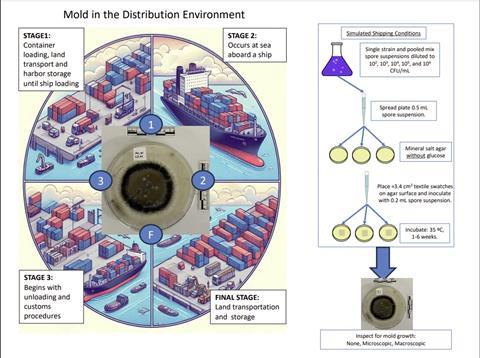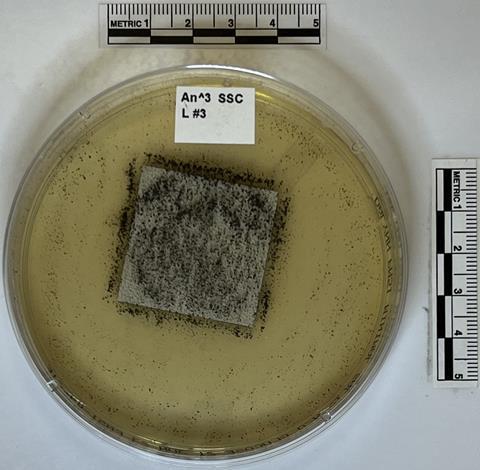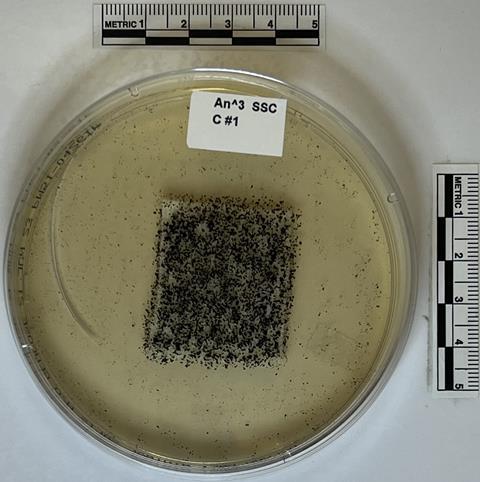A new study could help consumer goods manufacturers to predict the likelihood of mold growth during shipping, enabling them to make informed decisions and mitigate economic losses.

The paper, ‘Assessing Mold Growth Severity on Various Textiles: Comparative Analysis of Inoculum Densities and Fungal Strains’ recently appeared in Sustainable Microbiology, an Applied Microbiology International publication.
The textile industry faces significant challenges related to mold proliferation during shipping and storage, particularly in warm climates. Mold growth can lead to economic losses and health risks associated with contaminated textiles, said corresponding author Ann Hammad of Chinook Contract Research Inc. in Canada.
Mold exposure
“Our study aimed to identify how different textile materials respond to mold exposure under conditions that simulate real-world shipping scenarios, thereby informing better practices for preventing mold contamination. The influence of extended transit periods, varying environmental conditions, and the potential for mold proliferation during shipping has yet to be fully explored,”she said.
“This study simulates mold growth on different textile materials under conditions representative of overseas container shipping. This study pioneers an investigation into the minimum starting mold density on textiles that can induce visible damage, providing invaluable insights for consumer goods manufacturers.”
Minimum viable fungal cells
To detect the presence of mold and mold spores on consumer goods well before they are shipped and/or transported to their final location, the team needed to determine the minimum number of viable fungal cells required to cause visible damage.

“There is a significant gap in understanding the impact of overseas container shipping conditions on mold growth on textiles. This study qualitatively and quantitatively compared mold growth severity of a range of inoculum densities of fungal species on different textile materials under simulated shipping conditions,” Ann said.
“We established an estimate of minimum fungal densities for visible mold growth for 6 fungal strains on 6 textiles based on a Visual Mold Assessment Score (VMAS).”
Textile susceptibility
The study evaluated textile susceptibility to fungal contamination during transit by examining growth patterns, onset times, and determining minimum fungal densities for visible mold growth.
Inoculations of six fungal strains (individual and pooled) were conducted at inoculum densities ranging from 10^2 to 10^6 spores/mL on various textile materials. The study comprised two phases: Pilot Growth (PG, with glucose) and Simulated Shipping Conditions (SSC, without glucose).

PG yielded mycelial mats on all textiles for all fungal strains except Penicillium citrinum and Stachybotrys chartarum. SSC exhibited variable susceptibilities, with cotton and suede highly susceptible, whereas polyester, imitation suede, and polyurethane were notably resistant to mycelial growth. Minimum fungal densities for visible mold growth were established for each textile based on SSC.
Most invasive strains
In cases where the contaminating fungal strain is known, Aspergillus niger and a mix of fungal strains were found to be the most invasive of the strains tested and were accordingly assigned the lowest minimum density with the shortest shipping duration.
Ideally, materials contaminated with A. niger or a mix of fungal strains should be decontaminated or, if not possible, isolated before shipping.

Trichoderma reesei demonstrated slightly less invasiveness, so was assigned a higher minimum density but within a similar shipping timeframe.
Conversely, Cladosporium sphaerospermum, Chaetomium globosum, and P. citrinum demonstrated even less invasiveness, in order of highest to lowest, and so were assigned higher minimum densities with increasing shipping durations. S. chartarum values were based on visible growth on suede only since no growth was observed with the other textiles tested.
Vulnerable textiles
Meanwhile, in cases where the contaminating fungal strain is unknown, but the contaminated textile is known, cotton and suede were found to be the most susceptible materials to fungal contamination, being assigned the lowest minimum density with the shortest shipping duration. Ideally, these textiles should be decontaminated before shipping.
Polyurethane showed moderate susceptibility and so was assigned a slightly higher minimum density but with the flexibility of a longer shipping duration. Finally, leather, polyester, and imitation suede were found to be the least susceptible of the tested textiles, allowing for much higher minimum densities and much longer shipping durations.
“Leather displayed zones of inhibition for several fungal strains but one thing that was very interesting was that some molds eventually grew into these zones as incubation progressed. Additionally, Stachybotrys chartarum showed limited growth on most materials, contrary to its reputation as a common indoor mold,” Ann said.
“With only a few companies budgeting for mold damage and reconditioning, this research aims to equip consumer goods manufacturers with a predictive tool to assess the likelihood of mold growth during shipping, enabling them to make informed decisions and mitigate economic losses.
Way forward
Future studies should investigate whether mold growth on textiles is due to the fungi utilizing the textile material itself as a carbon source or if it results from contamination with external carbon sources. This would help clarify the mechanisms driving mold proliferation on different materials,” she said.
READ MORE: Study suggests how to curb spread of mold in future space stations
READ MORE: Scientists knit futuristic eco-building designs using fungal networks
More research also needs to be done to examine how varying concentrations of mineral salts influence mold growth on textiles, and assess the impact of pre- or post-treatments and environmental contamination on mineral salt levels and their role in facilitating or inhibiting mold growth.
Future research should also simulate real-world shipping conditions by incorporating temperature and relative humidity fluctuations in experiments, and also compare mold growth under constant versus fluctuating environmental conditions to better understand its behavior during actual shipping scenarios.
Background to study
The study was led by Chinook Contract Research Inc. (CCR), a Canadian Contract Research Organization, in collaboration with Micro-Pak Ltd., a global leader in mold prevention. Micro-Pak funded the research, leveraging its extensive experience in providing innovative, safe, and sustainable packaging solutions to protect consumer goods from mold and moisture damage. This partnership enabled CCR to investigate the minimum number of viable fungal cells required to cause visible damage to consumer textile products, addressing critical issues related to mold contamination during shipping and storage.
‘Assessing Mold Growth Severity on Various Textiles: Comparative Analysis of Inoculum Densities and Fungal Strains’ appears in Sustainable Microbiology, an Applied Microbiology International publication.







No comments yet